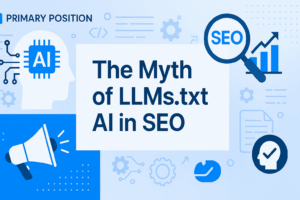Table of Contents
ToggleAn SEO Friendly CMS primer
It makes me sad when I see how agencies claim to be digital-first and SEO friendly and then…..The simplistic non-effort these agencies put into making websites channel-friendly, especially when it comes to SEO, is disheartening. Search engine optimization is the largest provider of practically free traffic. It is by far the most cost-effective lead generator for both B2B and B2C companies. An unseen website cannot attract new traffic. People don’t share websites simply because they like them. It’s highly subjective and tends to reflect the design likes of a marketing team that is often inexperienced in traffic and web traffic channel development.
“If you build it, they will come” may have worked for Kevin Costner in Field of Dreams. But for thousands of companies that rebuild their website each year, the naive hope that it will attract visitors just because it’s new and “pretty” just doesn’t cut it anymore..
Web Traffic Channels
Web traffic doesn’t come from word of mouth. It comes from an inbound channel, such as social, referral, or search. If the search is not your biggest driver of traffic, then you’re either in a new niche or you’re doing something wrong. Channels like social and referral take time to build. Plus, they are inconsistent and provide fractional click-through rates compared to impression rates.
The worst SEO myths persist at the web design agency level. So many web designers treat SEO as superstition vs. opportunity. When the design agency treats search as an afterthought, it handcuffs the SEO agency. A website should not be built without input from the SEO manager of the company. The following is not a comprehensive wish list for the best-ever SEO “friendly” website CMS. It’s more of a basic list of minimum requirements that any SEO manager, whether in-house or at an agency, will need to get started.
Basic elements for a minimally viable SEO-friendly CMS
The ability to edit and control the following:
- Page title
- H(x) Title tags (H1, H2 etc)
- Create web links
- Embed code and video (which should be a copy and paste of a YouTube URL – forget Vimeo please)
- Create lists
- Create tables
- Insert images
- Control of metadata, OG, and Schema
SEO Friendly CMS Infrastructure Management
Many web developers have direct control over hosting and HTaccess but give little thought to SEO and content producers who need to put in 301s and manage 404s. A big part of managing the infrastructure of a site where content is being produced and optimized means being able to quickly detect and manage 404’s and prevent them in the first place.
404 Custom Page
Basic 404 Management means having a custom 404 page that is user-friendly and links to the most important pages. An even better way would be to analyze the URL and suggest pages based on the words used in the URL – for example, if the user is sent to “mydomain.com/coffee/how-to-grind-coffee” – you could have a list of the top 3 or 5 pages with “how, grind, coffee” in them.
404 Hitlist
Every CMS has a plugin that lists when a 404 error was hit – this allows SEO managers to put in 301 redirects which helps with both SEO and UI/UX.
CMS 301 redirects
Every CMS needs to provide the ability to tie up loose ends. While some CMS applications like WordPress and Hubspot auto-301 blog posts if you modify the URLs, they don’t always do this if the URL is deleted or for landing pages.
404 pages are horrendous from both a UX (User Experience – the one thing that web agencies claim to be experts at) and an SEO perspective. 404’d pages bleed users and lost incoming authority from external links. They also keep the authority vs. page footprint expanded while Google tries to keep the URL alive in case it was accidentally deleted. Implementing a 301/302 is an efficient way to solve these SEO gaps.
CMS and SEO Sitemaps
Sitemaps are important to SEO but not for the reasons you might think. There are many different types of sitemaps:
HTML sitemaps
- Great for making sure all the pages you want indexed/findable are listed on one page
- Should be linked from the footer
- List orphan, comparison, and gated pages you might get organic traffic to
XML Sitemaps
- One of the most important features you can add to a sitemap that Google supports: the date the page was last updated – this ensures that edits and new pages can get crawled faster (authority still required)
- Most CMSs (e.g. WordPress) automatically produce XML (as RSS) sitemaps and many agencies tend to break them for some reason
- Most sites have just one or two XML sitemaps
- You can add sitemaps for
- Listing other sitemaps, where you have more than 10k pages per list
- Video lists
- Separate sitemaps for videos, blog posts, pages, etc
- XML sitemaps help SEO managers work out what % of the published pages are indexed
Adding a sitemap isn’t going to single-handedly improve SEO. It’s just like having windshield wipers on a car. You’re not going to use them every day, but they come in really handy when you need them.
Read: Google Sitemap Guide
Build in Google Tag Manager and give the keys to the marketing team
If you’re not using tag manager, please consider a job in a different industry. Maybe gardening.
Open Graph and your CMS
While Open Graph data is published in HTML, social media sites like Facebook, LinkedIn, and Twitter decided to adopt it. It’s essentially republishing the same data, but in a structured way that is consistent with the channels. The content is also specific and stricter than HTML, which is often ambiguous and open to interpretation.
Essentially, the most important elements are:
- URL
- Post Title
- The image you want to use – often the hero or a special version that is in the golden ratio (1.9:1)
- Post Description
- Post-Author
- The social ID of the publisher
- Estimated time it takes to read
They are optional, but the title, image, description, and URL are the most important. This is pretty much just a copy+paste of the page title, description, and author text and is repeated in HTML meta-tags (like Page Title, Meta-Description, Article Schema, and Author). It’s worth noting though, Open Graph is not really supported by Google, but it’s still a great thing to build in and much easier to do at the start since it’s applied site-wide on every page.)
Schema support in CMS
All CMSs’ should provide Schema for different content types, like Articles for Blog posts, Products for product listings, etc. They are not all required fields, but this helps Google tremendously.
Read more at: https://schema.org/
Thank you pages for Contact Forms
The whole point of commercial websites is to generate business. It is important for marketers to know sources from the first click (take note of Hubspot, Pardot, and Salesforce) and not just the last click. Google Analytics is generally the best place to track how visitors found, returned, interacted, and used different channels and content to become leads. Having Thank-you pages or event triggers is absolutely essential for attribution tracking.
Canonical Management in a CMS
Google deals with web pages based on exact URL taxonomy. For example, each of these URLs is a completely different web page::
- “mydomain.com/about-us”
- “mydomain.com/about-us/”
- “www.mydomain.com/about-us”
- “http://mydomain.com/about-us”
- “https://mydomain.com/about-us”
- “https:/www./mydomain.com/about-us”
- “http://mydomain.com/About-us”
If a page, especially in listing or directory sites (jobs, an e-commerce marketplace, property, travel, etc), can be published on multiple URLs (and even if not), use the Google Canon meta tag.
Read: Google Developer Guidelines for Canons
Tables, bullet points, etc
If you build a CMS or CMS Theme that doesn’t support tables, ordered/unordered lists, or video embedding, please know that there is a special place in hell reserved for you.
Be 100% sure of your SEO advice before you give it
The biggest problem with SEO myths is that people fail to fact-check. From duplicate content penalties to assigning Google human-like qualities (“Google doesn’t like when you.”) These myths are repeated in blog posts, forums, videos/vlogs, and even by some SEO agencies. Having read a blog post of following one particular SEO influencer isn’t enough to validate a theory about SEO. There’s a really good saying – you don’t know what you don’t know. When you have 20 years of experience in SEO, it is easy to see the enormous flaws in the logic in arguments presented by someone with 2 years of experience but typically, someone with 2 years of experience, doesn’t see the gap – they already feel they know 99% of what they need to know. That’s because there’s no general standard to be judged by and why it comes down to performance.
The most common myth is the “Content is King” myth pushed by content writers. Google can’t actually judge one piece of content over another. I know. I’ve written extensively about it. The fact is that quality is subjective. Grammar, spelling, style, and humor are all subjective and not useful standards for “quality.
Other myths that persist include page title lengths, meta-descriptions (something Google has never commented on except to reiterate that they will just make them up on the fly), meta keywords (this is not a real thing, please stop), word count, and keyword stuffing (e.g. repeating keywords).
The Google E-E-A-T Myths
A number of myths persist about Google E-E-A-T and we are working hard to dispel these but bascially: Google cannot make pre-determined decisions about content quality or presentation.
If you think something is wrong with your SEO, just Google it, since they’re the experts. But only pay attention to actual results written by people at Google. Google has an extensive and easily searchable Developer site with info on topics like canons, schema, FAQs, embedding videos, sitemaps, and more.
Just remember, when in SEO doubt, consult an expert. And don’t believe the myths.







